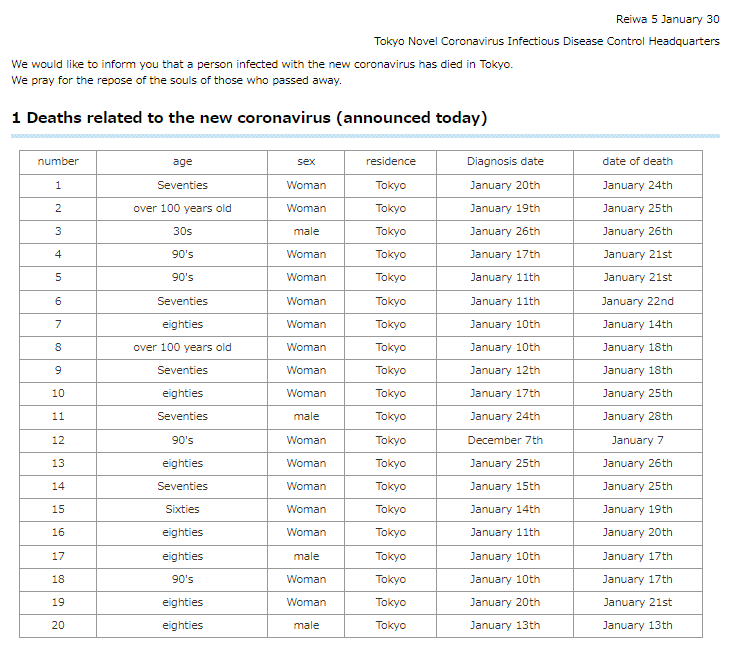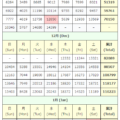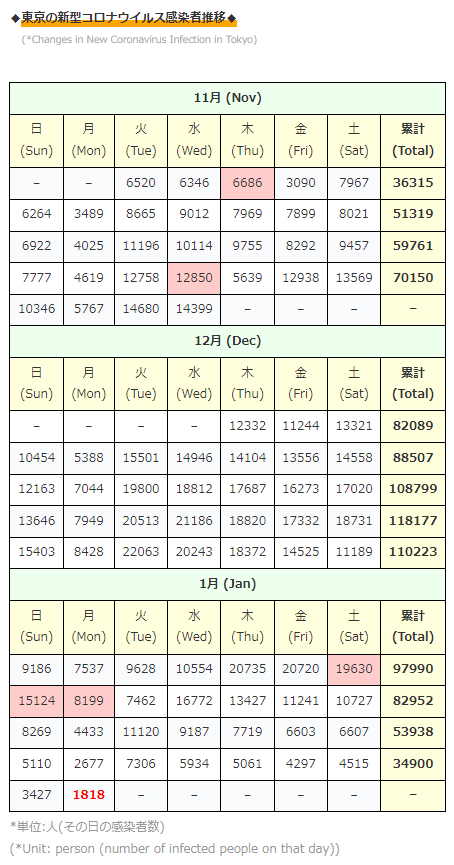
*** This article is written with the help of Google Translate… ***
1,818 (-1,609 from the day before) new infections confirmed in Tokyo.
◆◆◆ Japan ◆◆◆
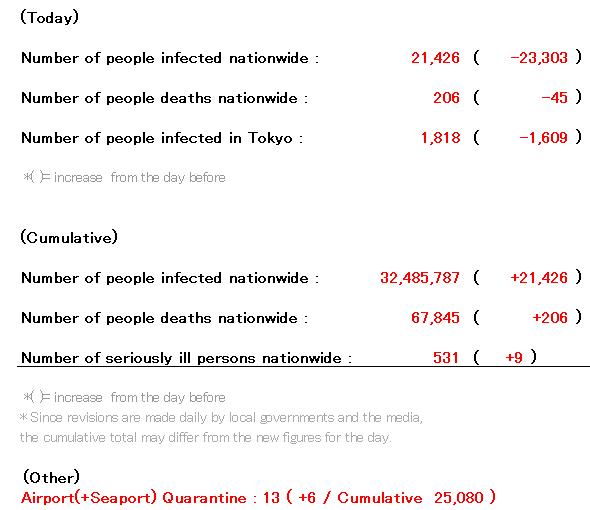
(*National number of discharged patients has been discontinued due to Limitation of targets for notifiable disease surveillance.)
(*As a result, it became impossible to calculate the number of COVID-19 patients in Japan.)
(Cumulative) * The following is up to 10 worst prefectures.
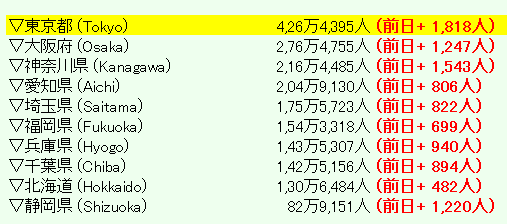
*( )= increase from the day before
(*All of the above from NHK NEWS WEB)
◆◆◆ World ◆◆◆

The number of infected people in Tokyo is…
The width of the decrease is halving every week, but it is still decreasing!
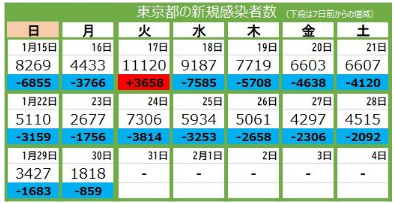
(*東京新聞)
In an average year, it seems to decrease until around March, but how about this time?
Meanwhile… How about the amount of people in the city in Tokyo…↓
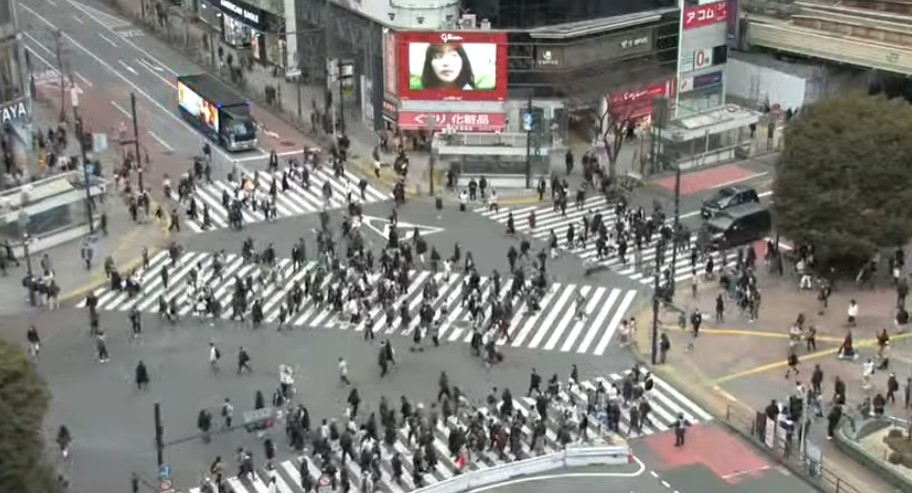
(Around 15:00 today, Shibuya Scramble Crossing, Tokyo)
Well, I will summarize
the breakdown of the number of new infections in Tokyo + α …!

(Individual infection information)
・ The positive rate in the test in Tokyo seems to be 【37.6%】 as of Jan 06
*The vaccination status of infected people has been discontinued due to the “Limitation of targets for notifiable disease surveillance”.
*The announcement of the number of “Exceptional patients with suspected symptoms” was also abolished due to “Limitation of targets for notifiable disease surveillance”.
(*”Exceptional patients with suspected symptoms” = Patients who were in close contact with symptoms and were diagnosed with infection without testing at the discretion of a doctor)

(As of Oct 01, 2022)
※*Tokyo currently has 32 facilities for infected people(February 22-)
(Capacity for a total of 9,100 beds)
(*Since space for staff and storage space for materials are also required, the number that can be accommodated is smaller than the number secured)
→As of October 31: 6689 beds (6280 beds + 409 beds for emergencies)
* A hospital in Tokyo has secured 6,737 beds
(6,442 for mild cases + 295 for severe cases)
→As of October 31: 3969ベッド(3738 beds + 231 emergency beds)
*The hotels are that,
1 the b ikebukuro 1-39-4 Higashiikebukuro, Toshima-ku
2 Day Nice Hotel Tokyo 2-1-1 Kiba, Koto-ku
3 Toyoko Inn Tokyo Station Shinohashi-mae 2-58-2 Nihonbashi Hamacho, Chuo-ku
4 East Tower (Shinagawa Prince Hotel) 4-10-30 Takanawa, Minato-ku
5 East Tower and others (Shinagawa Prince Hotel) 4-10-30 Takanawa, Minato-ku
6 Toyoko Inn Fuchu Nambu Line Minamitama Station 999 Daimaru, Inagi City
7 APA Hotel & Resort Nishi-Shinjuku Gochome Eki Tower 3-14-1 Honmachi, Shibuya-ku
8 APA Hotel Yamanote Otsuka Eki Tower 3-31-10 Minami Otsuka, Toshima-ku
9 Toyoko Inn Ikebukuro Kitaguchi II 2-51-2 Ikebukuro, Toshima-ku
10 APA Hotel Shinagawa Sengakuji Ekimae 2-16-30 Takanawa, Minato-ku
11 APA Hotel Pride Kokkaigijidomae 2-10-2 Nagatacho, Chiyoda-ku
12 APA Hotel Higashi-Shinjuku Kabukicho Tower 2-31-12 Kabukicho, Shinjuku-ku
13 Tokyu Stay Takanawa 2-16-29 Takanawa, Minato-ku
14 APA Hotel Shinjuku Gyoenmae 2-2-8 Shinjuku, Shinjuku-ku
15 Comfort Hotel Tokyo Higashi Nihonbashi 1-10-11 Nihonbashi Bakurocho, Chuo-ku
16 APA Hotel TKP Nippori Ekimae 5-52-9 Higashi-Nippori, Arakawa-ku
17 Hotel Gracery Shinjuku 1-19-1 Kabukicho, Shinjuku-ku
18 Tokyo Bay Ariake Washington Hotel 3-7-11 Ariake, Koto-ku
19 Candeo Hotels Ueno Park 1-2-13 Negishi, Taito-ku
20 R&B Hotel Kamata Higashiguchi 5-23-1 Kamata, Ota-ku
21 APA Hotel Omori Ekimae 1-1-4 Omori Kita, Ota-ku
22 Comfort Hotel Tokyo Higashi Kanda 1-9-10 Higashi Kanda, Chiyoda-ku
23 KOKOHOTEL Ginza 1-chome 1-9-5 Ginza, Chuo-ku
24 the b Akasaka 7-6-13 Akasaka, Minato-ku
25 R&B Hotel Tokyo Toyocho 2-1-5 Minamisuna, Koto-ku
26 APA Hotel Ueno Hirokoji 5-3-3 Sotokanda, Chiyoda-ku
27 Shinjuku Washington Hotel New Building 3-3-15 Nishi-Shinjuku, Shinjuku-ku
28 THE KNOT TOKYO Shinjuku 4-31-1 Nishishinjuku, Shinjuku-ku
29 APA Hotel Shinjuku Kabukicho Tower 1-20-2 Kabukicho, Shinjuku-ku
30 APA Hotel Asakusa Ekimae 1-12-16 Komagata, Taito-ku
31 Shinjuku Granbell Hotel 2-14-5 Kabukicho, Shinjuku-ku
32 Tokyo pet-friendly accommodation sanatorium 3-1 Higashiyashio, Shinagawa-ku
(Discontinued facility)
APA Hotel Asakusa Taharamachi Ekimae * Ended March 31, 3rd year of Reiwa
Tokyo Toranomon Tokyu REI * Ended March 31, 3rd year of Reiwa
Hachioji Sky Hotel * Ended October 31, 3rd year of Reiwa
Kichijoji Tokyu REI * Ended January 15, 4th year of Reiwa
※ 東京都福祉保健局 ※1施設追加|東京都 ※宿泊療養について(施設名一覧あり)
※ 東京で宿泊療養3千人止まり 即時対応難しく – Yahoo!
※新型コロナウイルス感染症の療養者の状況 – 東京都福祉保健局
※感染者総数試算のソースは東京都の『新型コロナウイルス感染症対策サイト』より
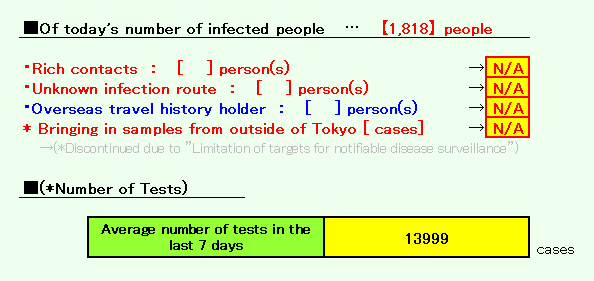
・Quarantine at the airport passengers arriving at the airport from overseas.
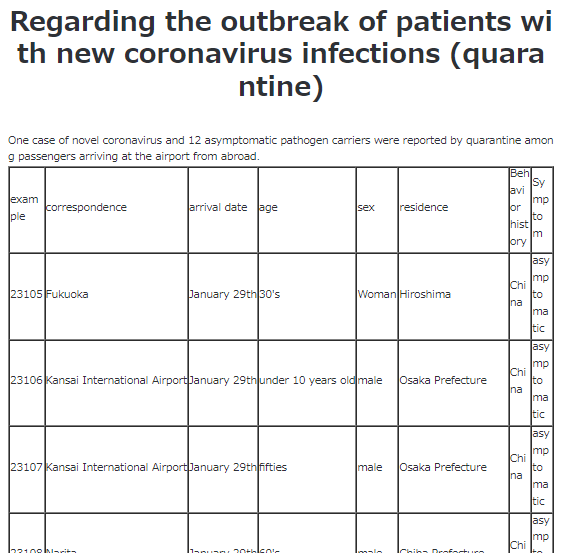
↓ ↓ ↓
(↑Please click the image to continue)
From the website of the Ministry of Health, Labor and Welfare
Click here for detailed information on current border measures and isolation period ↓
(*海外安全ホームページ – 外務省)
*Since the number of new infections in Tokyo seems to be almost the number of the previous day,
(Because the deadline for the number of new infections on the day is from 9:00 am the day before to 9:00 am on the day)
And also today, I will summarize some prefectures that have a high number of infected people, not just in the Tokyo area.
*** Saitama ***
・New infections are [822] people (*Max of up to yesterday=13991 *2022/08/05)
(Individual infection information)
・It seems that clusters have been confirmed in a total of [3] locations …
*** Kanagawa ***
・New infections are [(1543)] people (*Max of up to yesterday=16551 *2022/07/27)
(Individual infection information)
・It seems that clusters have been confirmed in a total of [7] locations …
・Including [?] people newly issued voluntary medical care notifications, the total number of new infections is [?] people.
(*Click here for information on the “voluntary medical treatment report” → from the summary article on August 23)
→”The numbers announced by Kanagawa were unreliable even before the Limitation of targets for notifiable disease surveillance was applied, but it seems that even those numbers are no longer announced due to it.
*** Chiba ***
・New infections are [894] people (*Max of up to yesterday=11776 *2022/07/28)
(Individual infection information)
・It seems that new clusters have been confirmed in a total of [5] locations …
* In addition, the number of infected people in each prefecture at the present time (19:00) seems to be like this! ↓
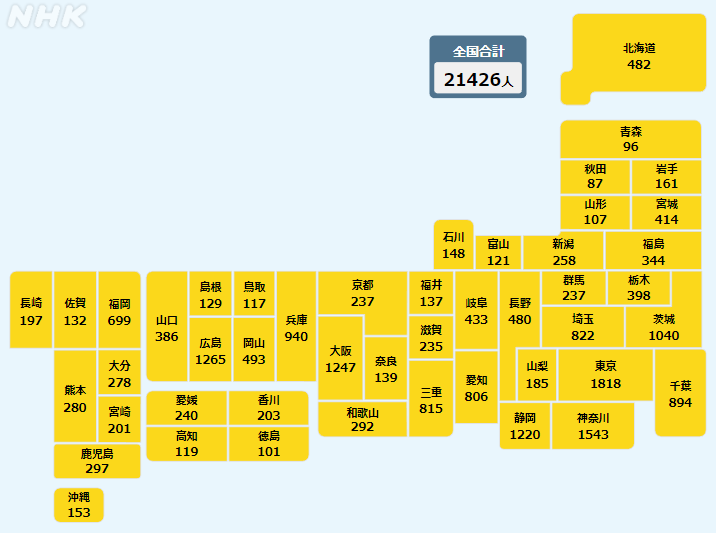
(*Since “Limitation of targets for notifiable disease surveillance” (September 26th), the figures announced by each prefecture have changed to those announced by the Ministry of Health, Labor and Welfare)
(*The number of infected people in airport quarantine is now added to the figures for the prefecture where the airport is located)
*Graph of the number of newly infected people in Japan as of yesterday

(*Since “Limitation of targets for notifiable disease surveillance” (September 26th), the figures announced by each prefecture have changed to those announced by the Ministry of Health, Labor and Welfare)
(*NHK NEWS WEB)
<Summary of today’s “Major News Related to COVID-19 in Japan”>
Last week, it was officially decided that the handling of COVID-19 under the Infectious Diseases Control Law would be changed from “type 2 = emergency” to “type 5 = common cold”.

Along with that, here’s a quick summary of what we know so far about what and how it will change!
<Changes in handling of COVID-19 under the Infectious Diseases Act>
■Time■
From May 8, 2023
■What will change■
Movement restrictions are completely removed.
It depends on each medical institution whether or not to respond to COVID-19 patients
(In a sense, it may be possible to see patients at more medical institutions than now)
Medical expenses will continue to be free (public expense)
The actual number of new infections will no longer be counted (only the numbers of some medical institutions are counted)
Wearing a mask is personal choice
Vaccines are free only if necessary
The limit on the number of people in the event has been virtually completely abolished
It will not be possible to “present a vaccination certificate” or “present a negative certificate” as a border control measure.

In addition, the reason why it was decided on “May 8” was said like this. ↓
・There were many voices from medical institutions and local governments that “a transition preparation period is necessary”
・The preparation period of “about 3 months” is based on the opinion of the Ministry of Health, Labor and Welfare’s Infectious Diseases Subcommittee (no explanation why 3 months)
・There was a concern that the infection would spread if the move was made before the long holidays (GW).
(*GW = Golden Week Holday =Japanese Long holidays from end of April to early May)
・ Considering the burden on medical institutions during long holidays (GW)
↑ If you look at it like this, after avoiding GW, there will be summer vacation and Obon vacation, but what are they going to do at that time? I can’t believe it…
By the way, regarding “movement restrictions”, the Japanese government will be completely unable to declare a state of emergency or recommend hospitalization!
…Please don’t say “Hey…, you couldn’t do it until now…”, OK? (dry laugh)
And it seems that the public expenditure (tax burden) for medical expenses will continue…
Even if you don’t get infected by taking proper measures against infectious diseases, if other people get infected, it seems that your precious tax money will be used properly…
And as a convenient excuse for changing to “Type 5”, “reduction of fatality rate” is emphasized considerably ↓
(Lethal rate per wave)

It feels like “If the number of infected people increases dramatically, it’s very natural that the fatality rate go down considerably,” but even so, this “lower fatality rate” tends to be replaced with “COVID-19 is no longer scary!”
As a side note, the actual number of deaths is like this ↓
Yeah, it keeps growing like crazy…! 🙁
The following were some of the concerns!↓
<Concerns about changing to Class 5>
■Seasonality of COVID-19■
・It is not seasonal like influenza, which is epidemic only in winter every year, and can be infected all year round.
→ No mention of solution
■Therapeutic ■
・Although oral medicines are used for COVID-19, the procedure for using it is complicated and it is difficult for people with underlying diseases to use it
■Medical Institutions where you can consult■
・Currently, there are fewer than for influenza
・In the future, there may be a world line where more medical institutions will not be examined because each governments will no longer secure “beds for COVID-19”.
・Even if the number of patients increases, there is a risk that they will not be able to be hospitalized because the government will not adjust hospitalization anymore.
・Eventually, the cost of treatment will be borne entirely by the individual, and infected people may not be able to receive treatment.
↑In the first place, there is still “no silver bullet” in terms of therapeutic drugs…
Omi, chairman of the government subcommittee, said, “Whether or not to allow infection leads to a debate about whether or not to allow a certain number of deaths,” but if you think about it that way, the Japanese government and the majority of the people are willing to let people die to some extent.
Hmm, seriously…
↓ In addition, there was such an article! ↓
(* There was no other news I would like to introduce today)
And this article↓
How long time the materials such as paper, cloth, plastic, etc. need to eliminating the risk when coronavirus is attached, and how effective disinfection is.
If you are interested, please take a look!
And here’s a trial calculation of how many people in Japan are actually receiving medical treatment.

Today, as I briefly mentioned above, changing to “Type 5” will make it completely impossible to know the exact number of new infections and the exact status of infections.
By changing to it, the number of infected people will change from “knowing all” to “knowing the number of fixed points = counting only the numbers of some designated medical institutions”.
This is the same counting method as the flu.
Well, however, in the first place, even now, they haven’t done a “complete grasp”... (dry laugh)
*The “Limitation of targets for notifiable disease surveillance” comes into effect on September 26, 2022.
(* “Limitation of targets for notifiable disease surveillance”” … Roughly speaking, in order to reduce the medical burden, only high-risk infected people are counted, and most mild and asymptomatic patients are not counted.)
(コロナ「全数把握」見直し、きょうから全国一律で開始 – 読売新聞)
Therefore, since the infection status of COVID-19 will not be known at all after the change to “Type 5”, it will be a situation where it is not even possible to know whether it is spreading in the first place.
In short, it’s like, “There are a lot of people around me who aren’t feeling well, but…why…?”
Even with influenza, there are many people who are vaccinated before winter every year, and they are wary of infection, but since COVID-19 is more contagious and prevalent all year round, so we have to be careful about what COVID-19 is going to be like in the future…!
Please be careful when you go out!
AcertainFox512
◆東京の新型コロナウイルス感染者推移◆
(*Changes in New Coronavirus Infection in Tokyo)
| 11月 (Nov) | |||||||
| 日 (Sun) |
月 (Mon) |
火 (Tue) |
水 (Wed) |
木 (Thu) |
金 (Fri) |
土 (Sat) |
累計 (Total) |
| – | – | 6520 | 6346 | 6686 | 3090 | 7967 | 36315 |
| 6264 | 3489 | 8665 | 9012 | 7969 | 7899 | 8021 | 51319 |
| 6922 | 4025 | 11196 | 10114 | 9755 | 8292 | 9457 | 59761 |
| 7777 | 4619 | 12758 | 12850 | 5639 | 12938 | 13569 | 70150 |
| 10346 | 5767 | 14680 | 14399 | – | – | – | – |
| 12月 (Dec) | |||||||
| 日 (Sun) |
月 (Mon) |
火 (Tue) |
水 (Wed) |
木 (Thu) |
金 (Fri) |
土 (Sat) |
累計 (Total) |
| – | – | – | – | 12332 | 11244 | 13321 | 82089 |
| 10454 | 5388 | 15501 | 14946 | 14104 | 13556 | 14558 | 88507 |
| 12163 | 7044 | 19800 | 18812 | 17687 | 16273 | 17020 | 108799 |
| 13646 | 7949 | 20513 | 21186 | 18820 | 17332 | 18731 | 118177 |
| 15403 | 8428 | 22063 | 20243 | 18372 | 14525 | 11189 | 110223 |
| 1月 (Jan) | |||||||
| 日 (Sun) |
月 (Mon) |
火 (Tue) |
水 (Wed) |
木 (Thu) |
金 (Fri) |
土 (Sat) |
累計 (Total) |
| 9186 | 7537 | 9628 | 10554 | 20735 | 20720 | 19630 | 97990 |
| 15124 | 8199 | 7462 | 16772 | 13427 | 11241 | 10727 | 82952 |
| 8269 | 4433 | 11120 | 9187 | 7719 | 6603 | 6607 | 53938 |
| 5110 | 2677 | 7306 | 5934 | 5061 | 4297 | 4515 | 34900 |
| 3427 | 1818 | – | – | – | – | – | – |
*単位:人(その日の感染者数)
(*Unit: person (number of infected people on that day))

